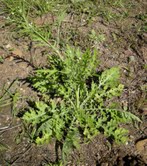Manali: Propagating from US to Maharashtra, then many other southern and northern states of India, the invasive and poisonous weed “congress grass” (parthenium) is now spreading unbelievably fast in Himachal Pradesh and causing “flora terrorism”.
The gajar buti, carrot weed or Congress grass (Parthenium hysterophorus) is becoming a nuisance not only on the bunds and field outskirts but also along the road sides, grain market yards and water ways, causing obstructions and skin allergy to human beings and animals.
Experts say a single plant of congress grass can produce over 20 thousand seeds and propagate with the help of wind, animals and humans.
Conservator of forests in Himachal forest department, Bhupinder Rana while talking to Hill Post said that few of the plants of this poisonous species were sighted in the lower areas of Kullu and Sanj valley 2-3 years back which now have multiplied into hundreds of thousands.

He added that though the plant had recorded its presence in Mandi, Una, Bilaspur and some other low altitude districts of the state even before this, but the plant is spreading its roots towards upper areas of the state.
Congress grass is a hardy weed that has the ability to tolerate harsh weather. It grows vigorously during rainy season and hibernates during winter months. Its leaves are serrated and resemble carrot with white colour flowers in September.
Rana disclosed that he is observing the deadly growth of this weed for last three years. “This poisonous weed is spreading very fast in Himachal. I had observed presence of few plants by the roadside in lower Kullu two years back and now it has occupied a large chunk of land which is matter of concern he said.
Rana claims that he and other employees of the department uprooted and destroyed parthenium plants from two hectare land around their office in Shamshi this August.
Conservator said that locally known as gajar grass, parthenium causes respiratory and skin diseases among human while cattle maintain distance from this weed for its poisonous properties.
He said if the weed invasion is in its primary phase, it can be eradicated manually by hands, otherwise it will start infesting other crops of the area.
“We have approached some environmentalists and NGOs to join hands to destroy this poisonous weed, otherwise it may prove a menace in the state in the near future as it impacts on human, crops and environment,” Rana said.
He added that starting from Mandi, congress grass (parthenium) can be seen upto Dhalpur, middle of the Kullu district, towards Manali.
The people need join hands to stop this flora-terrorism. This weed has entered the forest land and vegetable farms in lower Kullu. Once it spread in all parts of the state, its complete eradication will become very difficult.
According to a survey made by an independent organization, congress grass, which was first noticed in Maharashtra in 1956, is causing losses worth thousands of crores to the country by occupying lakhs of hectares of forest and arable land.

Sanjay Dutta, an engineer by qualification but is a journalist by choice.
He has worked for the premier new agency Press Trust of India and leading English daily Indian Express.
With more than a decade of experience, he has been highlighting issues related to environment, tourism and other aspects affecting mountain ecology.
Sanjay Dutta lives in a village close to Manali in Kullu valley of Himachal.



